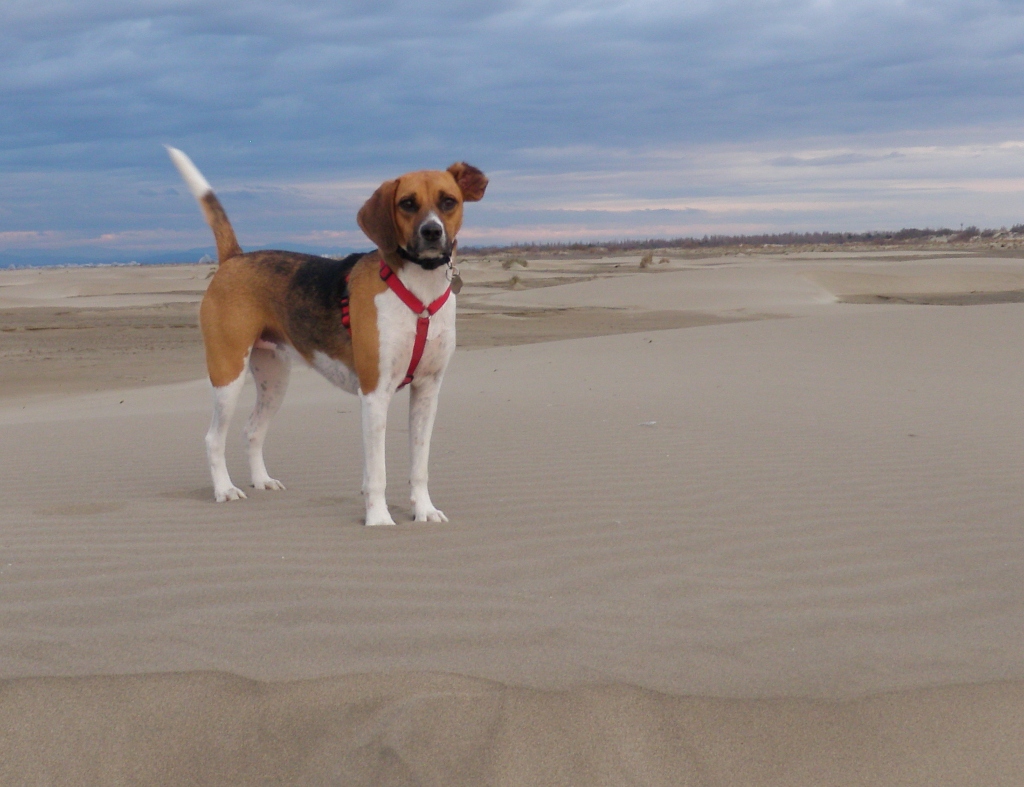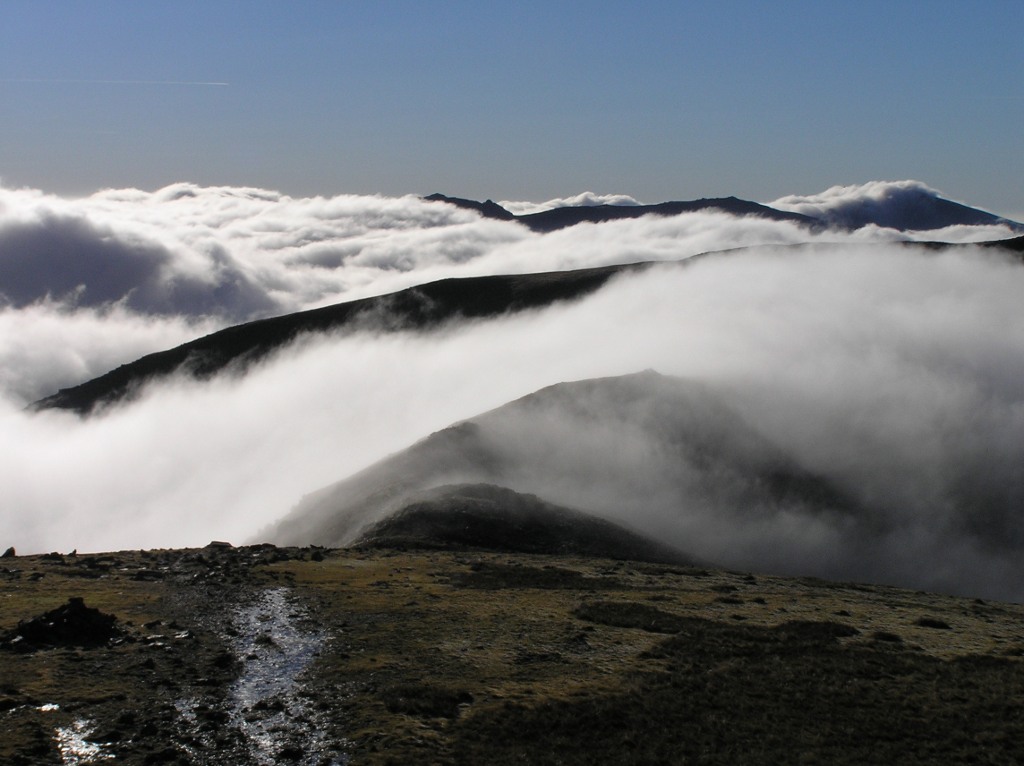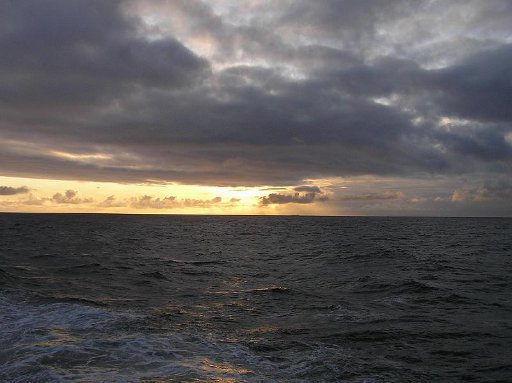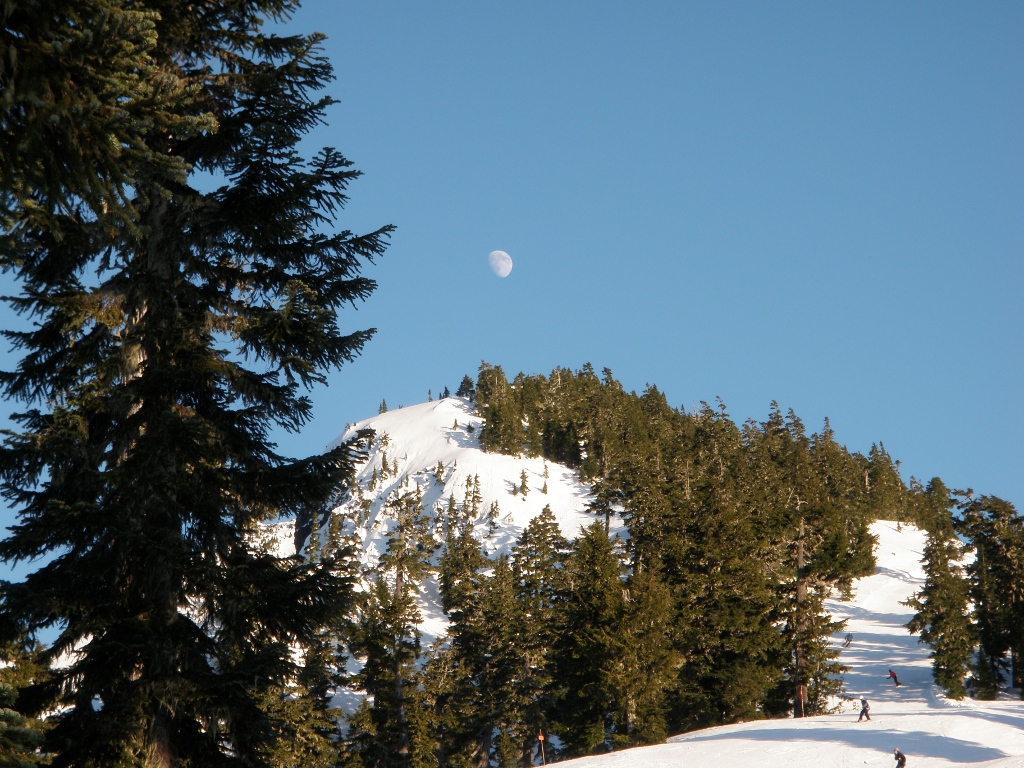Beach Time!
 Winnie!
Winnie!
Today, we had an early morning outing to the Plage de l’Espiguette, a big beach about 30 km east of Montpellier. We got up at 6:15, picked up the Modulauto car at 7:00, persuaded Winnie into the back (she’s still a bit scared of cars...) and off we went. We arrived at the car park before sunrise and were the only people there! Miles and miles of dunes were ours alone! Much frolicking there was. And climbing up and down the dunes. And digging. And chasing of sticks. And rolling around pretending to be a dog (just Ian, since Winnie is a dog, and Rita isn’t quite as silly as me). It was a lovely morning, and the dunes were very pretty indeed. We’ll be going back there again, some time before the summertime beach dog ban comes in. And hopefully, with more doggie company next time, since I think Winnie could have done with a four-legged buddy to run around with. I do my best, but I don’t quite have what it takes for serious boisterous play, since I can’t run at 40 km/h for hours and hours at a time...
Ping
For a brief period some years ago, I worked for an engineering firm that did sonar work for the (UK) navy. Many of the people in the company were ex-submariners, who had served both on the Swiftsure/Trafalgar attack boats and on the Vanguard missile boats. These were all pretty solid people, and I remember one in particular who delighted in telling stories about his time working his way up from a “baby sailor” to naval attaché to the British embassy in Washington, D.C. His most amusing tales included a reenactment (with actions) of the joys of carrying soup tureens around crowded submarines, and the entertaining ability of US spy satellites to dip into the atmosphere to take a closer look at interesting sights, like Soviet mini-subs stuck on their motherships in their pens.
A slightly less amusing story revolved around the hubris of submarine commanders. He sent some of us a photograph showing £20 million of towed sonar array snarled up around a mooring buoy, all because the sub commander couldn’t be bothered to wait for the divers to help reeling the thing in. A sad navy man with a big beard stood gazing at the pile of expensive spaghetti, looking like he might burst into tears at any moment. Not the navy’s finest moment.
Link Round-up
Some interesting things that passed through my RSS reader recently:
Food pairing and flavour networks
This is kind of interesting. Why do cheese and bacon (if you eat that kind of thing) go together so well? Or asparagus and butter? Or caviar and chocolate? (Apparently. If you’re Heston Blumenthal.) The hypothesis was that these “paired” foods had many flavour compounds in common. The data presented in this preprint seems to confirm that idea for Western cookery, but contradict it for Asian cuisine. There’s a lot more in there about the evolution of recipes, clusters of ingredients, and other network analysis goodness.
Economists doing something right?
The people at Crooked Timber always have a lot of interesting things to say. This is a summary and some discussion of a meeting at the New Economics Foundation talking about the need to cut consumption and spread wealth around by redistributing working hours. From a personal point of view, the idea of earning a reasonable salary from a 21-hour working week and having time to work on personal projects, do some volunteering, spend time with Rita and Winnie, all sounds great. From a social point of view, a gradual redistribution of working hours to reduce unemployment and spread income around more fairly also sounds fine. It seems unlikely to happen, if only because NEF seems to be the only group of economists who can bear to think about the end of economic growth and a transition to a steady-state economy. When I listen to mainstream economists speak, I have this image in my mind of a train racing along a bridge which is being frantically cobbled together bit by bit as the train approaches. Sometimes the train gets closer to the edge, sometimes it backs off a little way. But in the long run, the bridge builders can’t win. They’re just going to run out of stuff to build more bridge.
Some good news
To leaven the economics misery, this is really good. Polio is on the way out in India: not one new case in the last year!
Friday photo #7
Carnedd Llywelyn, North Wales. January 2006.
Eight legs good, two legs bad!
Along with a lot of other people, I’m a big fan of cephalopods. I’ve dived with squid and cuttlefish and have watched octopus while snorkelling. I particularly remember following one cuttlefish across a reef in the Philippines, watching its mesmerising pattern display, until it got bored of the clumsy and noisy thing with too few appendages plodding along behind it and made off for deeper water.
Octopus, in particular, are smart little critters. One of the saddest things I’ve ever read was a section of a book about octopus physiologyI really like octopus, OK? I think the book was Octopus: physiology and behaviour of an advanced invertebrate by M. J. Wells, although it was a while ago that I read it. that talked about the effect of certain nervous system lesions on the behaviour of octopus–these were lesions induced by human experimenters, of course. The writer talked about how the cephalopod victims cowered at the back of their tanks and clearly were less than keen on being used as experimental subjects. It stuck in my mind as the only place in the book (otherwise a good and thorough treatment of octopus physiology) where the author seemed tempted in any way to anthopomorphise or to ascribe emotions or feelings to the octopus. That’s why Octopus vulgaris is the only invertebrate protected under the UK’s animal experimentation laws...
Anyway, octopus are very cool and a fascinating model for non-human (and non-vertebrate!) intelligence. A recent article in Orion magazine does a great job of getting across just how amazing these creatures are. Go and read it. If they lived a bit longer and could be trusted not to molest the dog, I would love to have an octopus to live with us. Alas, I don’t like to imagine what would be the result of Winnie versus a Pacific giant octopus. Messy, for sure.
Container Cruising
Uh-oh. Getting a bit behind on this 30-day challenge. Time for some shorties...
Not really a “past life” as such, but something interesting I did a while ago that was brought back to mind by the Costa Concordia cock-up. I’ve not spent a lot of time on big ships, indeed until 2007, I think the only larger vessels I’d been on were ferries, cross-Channel or around the Greek islands.
In April 2007 though, I went to Canada for a big trip, mostly to visit some potential future places to live and work and to attend a workshop at the Banff International Research Station. I flew out to Vancouver, took a ferry to Vancouver Island where I visited UVic (ended up working there for a couple of years afterwards), then travelled east by train. I made it as far east as Halifax, Nova Scotia, all by train. That was a pretty cool experience in itself, but I’d had a wacky idea for how to get home from Canada to the UK. It’s possible to book passage on container ships under some circumstances, which I decided to do. It’s a tricky process, not super cheap, and the logistics of making the rendezvous with the ship turned out to be a bit more “interesting” than I expected.
Cabins
I’ve been thinking for a long time, mostly privately in my idle moments, about the sort of house I’d one day like to build for myself. I have some ideas that I think are pretty cool: multiple small wooden buildings, connected by walkways, with the main building on a slope with a stepped living area; a separate Japanese-style bathhouse; an octagonal library/study with windows all around; a cellar dug into the side of the hill.
Of course, all of this is nothing more than idle daydreaming. Recently though, Rita sent me a link to some pictures of cabins (sheds, huts, that sort of thing) that capture a lot of the spirit of what I’ve been thinking of. You can see them here (yes, the link is safe!). Some of these places look heavenly.
Now That’s How You Use A Camera...
I’m a sucker for nature photos. One of our annual outings when we lived in Bristol was to the Nature Photographer Of The Year exhibition at the city museum. Going by the crowds there, we aren’t the only ones who like this stuff.
So, here’s some eye candy.
Friday photo #6
Mt. Cain, Vancouver Island. New Years, 2010/2011.
Puppy Purgatory
 Speedy Dog goes where she likes!
Speedy Dog goes where she likes!
Well, maybe not any more, little girl...
Yesterday evening, we had a meeting with Martine, the dog behaviourist who’s helping us with Winnie. Winnie has come a long way from the terribly frightened little dog that we picked up from the animal shelter four months ago. She’s no longer terrified of everything in sight, she runs around with her tail up, likes to play with other dogs, likes to sniff in the bushes, likes to run crazily through the fallen leaves in the forest. She’s still jumpy and easily gets scared of people in the street or sudden noises, but she’s come a long way.
Past Lives: Part III Maths
I’ve been very lucky so far in my life, and have had many opportunities to work and study in interesting places. I’m not sure I’ve made the best use of those opportunities–there’s much that feels unfinished or that didn’t quite work out the way I’d hoped it would–but these “past lives” have given me a lot of experience working in different fields, living in different places, hanging out with different kinds of people.
Blogging is inherently self-indulgent: you have to assume that someone out there is interested in reading your maunderings. (Not really. Honestly, I do this for my own amusement.) The ultimate in self-indulgence has to be autobiographical blogging and reminiscing, where some old fart bends everyone’s ear about the “good old days”. Anyway, since this is for my own amusement and for a bit of writing practice, I don’t really care. I’m going to be brazenly self-indulgent and start writing “Past Lives” articles to see if I can dredge up any interesting memories.
Minds and mathematics
In 1998, the mathematical physicist David Ruelle wrote an odd little article, entitled Conversations on Mathematics with a Visitor from Outer Space, which appeared as a chapter of the very interesting looking book Mathematics: Frontiers and Perspectives, published by the IMU in 2000. I’ve not read the whole volume, although I think I’ve read at least one of the other chapters as a preprint. Most of the 30 authors seem to have written more or less “straight” articles, but Ruelle’s is different. He wanted to explore the constraints imposed on human mathematics by the structure and capabilities of the human brain. Perhaps constraints is too strong a word–“predispositions” might be better: human mathematics is necessarily tied to human brains, and human brains have evolved to their current state to solve problems that are quite different from the problems encountered in mathematics. One might thus expect human mathematics to have followed the “fault lines” in the Platonic edifice of Mathematics that are most easily appreciated using the mental tools that evolution has given us.
To explore this idea, Ruelle introduces the conceit of a visitor from outer space, a “galatic mathematician” pursuing doctoral studies investigating the nature of human mathematics. She describes some of the characteristics of the human mental apparatus that are relevant: limited short-term memory, and hence inability directly to execute complex algorithms; predisposition to see symmetry and pattern; human brains operate very slowly, even compared to human computers; the importance of geometrical and visual reasoning; and so on. Ruelle comments that despite our limitations, humans have managed to do some fairly complex mathematics, but the question is always: how much further could we go if we could transcend the limitations of our history?
Holiday Reading #3
A couple of more substantial (in length) books I read over Christmas were Neal Stephenson’s latest and the first of Tim Powers’ Fisher King series. I liked them both.
We never dropped a bomb. We never fired a bullet. We never went to war.
I was born in the UK in 1972. The “world leaders” who defined my youth were Margaret Thatcher, Ronald Reagan and Leonid Brezhnev. This may have something to do with why I am so bitter, cynical and generally misanthropic nowadays, although the star turns we’ve seen in the US, UK and former USSR since then may have helped too.
Before Reagan, there was Jimmy Carter. I remember him from the TV news at the time only very vaguely. Since missing re-election in 1981, Carter has worked on a vast range of issues, mostly to do with disease eradication in developing countries and election supervision in fragile democracies. That his name can send the US right wing into a frothing ball of fury seems to indicate that he’s been doing good things.
A recent interview in The Guardian brought home just what a great man he is. The description of his house and his manner make me think more of a Greek senator elected by lot than a modern American politician with all the schmaltz and money that goes with it. He’s a humble man who has lived his beliefs. That deserves a lot of respect.
The other thing that comes across in the interview is his intellectual engagement. I loved the story from his chief of staff that he only once was able to tell Carter something that he didn’t already know. If you have any sense, you don’t choose a leader you’d be happy to have a beer with (don’t know if Carter even drinks); you choose a leader who is intelligent, motivated and honest. Carter is all of those things.
Friday photo #5
Door, Kairouan, Tunisia. April, 2005.



